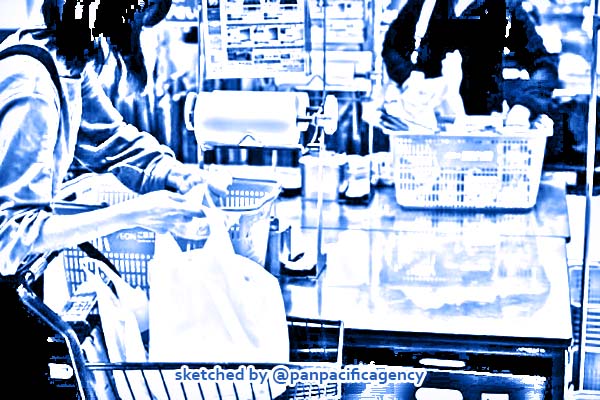China’s food delivery boom may undercut plans to reduce plastic bags

The move to charge for plastic bags brings Japan in line with many other countries that have already adopted the environmentally friendly measure Photo: AFP. Sketched by the Pan Pacific Agency.
BEIJING, Jul 27, 2020, SCMP. Every day, about 10 plastic bags come into Li Xin’s home in Beijing, filled with food and other daily necessities bought from local stores or online. The 40-year-old housewife throws away the thin and flimsy ones and reuses the rest as rubbish bags, South China Morning Post reported.
Li seldom takes a reusable bag when shopping, finding it “troublesome” and said she was “already supporting environmental protection by reusing them to carry waste.”
China – one of the world’s biggest users of plastics – will ban non-degradable plastic bags in supermarkets, shopping centres and flourishing food delivery services in its major cities from next year. At the same time, non-degradable, single-use plastic straws, plastic cotton buds, and foam plastic disposable dinnerware will no longer be allowed nationwide, according to a plan issued earlier this year.
But environmental activists fear the ban may lead to little change, failing just as Beijing’s first action against plastic pollution did 12 years ago. One reason may be the continuing difficulty in changing public attitudes.
China first attempted to encourage consumers to use less plastic in 2008, introducing a charge for plastic bags in supermarkets, shopping centres and food markets. But for Li, the cost – at 0.2 yuan (less than one US cent per bag) – is negligible.
“I can’t tell which plastic bag is degradable and which is not. I guess I’ll need pay 0.2 yuan more to buy degradable bags with this new order?” she said.
China generated more than 211 million tonnes of municipal solid waste in 2018, of which around 12 per cent was plastic, according to the Ministry of Housing and Urban-Rural Development.
Worldwide, the top contributors of plastic waste are East Asia and the Pacific, which produced 57 million tonnes – or nearly a quarter of the global total – in 2016, according to the World Bank.
Yao Jia, a Beijing-based activist who launched the Joint Investigation Team for Reduction of Plastic Use several years ago, said the logic of the new directive was to gradually phase out non-degradable plastics on the one hand, while on the other discouraging plastic bag use as the degradable versions were more expensive.
“Especially as the food delivery service booms, hopefully restaurants can use more reusable containers as costs for bags rise,” she said. Yao said the wholesale price for a degradable bag was about 0.3 yuan, compared to 0.1 yuan for non-degradable.
But Wang Xuliang, who has run a noodle shop for 20 years on Lancun Road in Shanghai, doubted he would be doing so. “It doesn’t sound feasible to me, at least for the near future, when everyone will still be used to getting their lunchboxes in a bag,” he said.
Wang said he did not expect to use the more expensive types until there was a serious crackdown from local authorities. “A directive is a directive. How it’s implemented in reality is another thing.”
Yao said an investigation by her team showed more than 90 per cent of food markets across China were still offering free, non-degradable, ultra-thin plastic bags – which take 200 years to break down in the environment – to consumers in 2016, eight years after Beijing banned giveaway bags and the use of plastics thinner than 0.025mm.
Things improved in the following years, but not by much, Yao said. In 2017, an investigation of more than 100 markets around the country found only about 12 per cent were using permissible bags. That figure rose to 28 per cent in the team’s latest investigation this year, she said.
In the meantime, the situation has worsened. “We’re facing new challenges as people’s lifestyles have totally changed in the past few years – people have their food delivered to their homes and buy nearly everything online, leading to a surge in plastic bag consumption,” Yao said.
China’s ubiquitous express delivery industry consumed more than 9 million tonnes of packaging materials in 2018, according to a report by environmental group Greenpeace and two other NGOs.
The new plastics directive aims to reduce consumption of non-degradable utensils in the food delivery service by 30 per cent in major cities by 2025.
However, degradable plastics should not be regarded as the solution, according to Chen Liwen, an environmentalist who has dedicated the past decade to waste issues in China. “There are many different types of degradable materials and we have yet to clarify these. For many of them, it can still take half a year to degrade in industrial composting plants,” she said.
“To replace the non-degradable with degradable still helps little in reducing waste. The ultimate solution should be replacing single-use items with reusable ones.”
Although China lags far behind the US and Europe, where a more sophisticated plan targeting a wider range of single-use plastics took effect last year, Beijing has stepped up its actions to address the deluge of plastic in recent years.
As a major consumer of the bulk of scrap plastic from around the world, China stopped importing almost all foreign plastic waste, and many other recyclables as well, from 2018. In March 2017, the central government set out plans for a standardised system and regulations for rubbish sorting to be in place by 2020, with a target for 46 major cities to recycle 35 per cent of their waste by then.